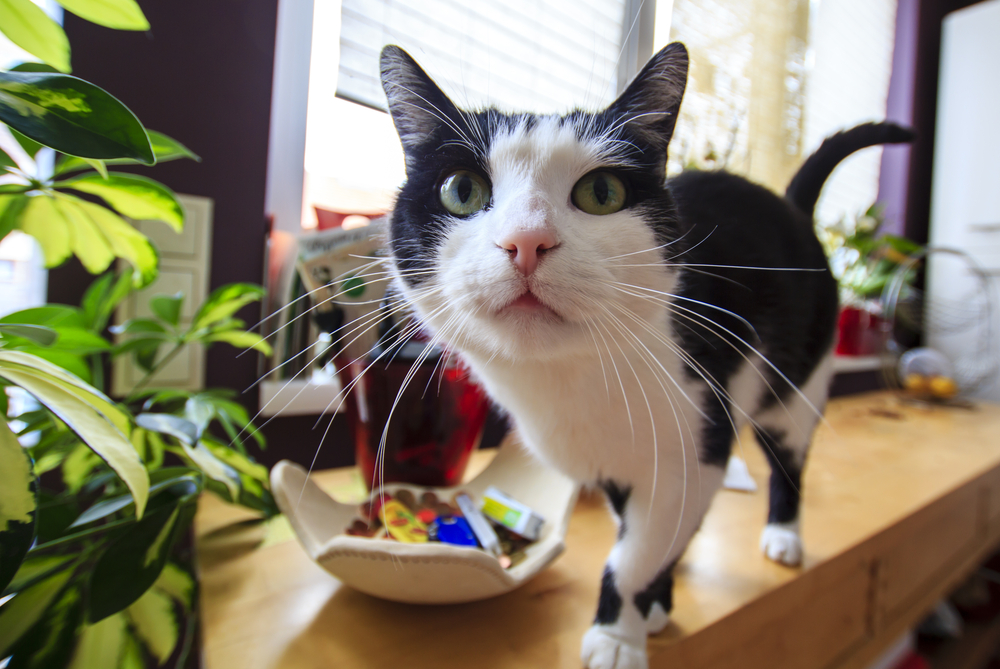Everyone loves to have fun in the sun—and it’s more fun if you can share it with your pet. But summertime’s fabulous rays bring a whole host of risks for your pet. Here are the top five risks that may affect you and your pet during the hottest season, and how to prevent and treat them.
#1: Too much sun for your pet is not a good thing
Alan Jackson may sing, “Too much of a good thing is a good thing,” but it’s not true for pets and sun. Pets can only sweat through glands on their paws and can easily overheat and become ill with heatstroke, a serious condition, so be careful about where and when your pet exercises. Dogs and cats should be watched for the following distress signs on warm days:
- Excessive panting
- Lethargy
- Vomiting
- Diarrhea
What to do: The best way to deal with the risk of excessive heat is to help your pet avoid it. If possible, keep your pet inside, or at least in the shade and out of direct sun. Ensure she always has plenty of fresh, cool water—hydration is the body’s first line of defense against heat illness. If your pet shows signs of heat illness, move her to a cool spot, such as a basement, and in front of a fan, if possible. Wet your pet with lukewarm water to speed her cooling. Never use icy cold water, which can cause life-threatening complications. Then, take your pet directly to our office or the nearest emergency veterinarian, because heatstroke is serious and can cause organ failure if untreated. Your pet may require hospitalization. The faster you act, the better your pet’s chance of making a full recovery.
#2: Sun burns pets, too
Sun affects pets externally—particularly noses and ear tips—as well as internally. Many people don’t realize until it’s too late that pets, especially dogs with white or light fur and pink skin, can get sunburned, too.
What to do: Be careful about using sunscreen you have lying around and ensure you use a product specifically formulated for pets. Sunscreen intended for human use can contain ingredients that are toxic to pets. Ask our team for recommendations.
#3: Pets and burned paws
Perhaps the most surprising summertime injury pets suffer is burned paws. Pets have no hair on their foot pads to protect against hot surfaces. If the air temperature is 90 degrees, asphalt temperatures can reach 140 degrees. Burns can occur at temperatures as low as 110 degrees.
What to do: Avoid hot surfaces, such as concrete, asphalt, and gravel in the heat of the day. If you can’t avoid hot surfaces, consider buying your pet booties, which are available in various styles.
#4: The car can be an oven for pets
Temperatures inside a car can climb 40 degrees in 30 minutes, turning your car into an oven faster than you realize. Pets should be kept out of the car whenever possible, and never left alone in a vehicle, even if the air conditioning is running.
What to do: Never leave your pet alone in a car, even for a short time. If you have to travel with her in the summer, always take her with you when you leave. Keep the air conditioning on, and always carry bottled water on your trip so your pet is assured access to clean water.
#5: Toxins

Like sunscreen, other summertime human products contain ingredients that can harm dogs. Insect repellent, DEET, insect coils, and citronella all pose threats to your pets.
What to do: Don’t use people products on or near your pets, including essential-oils-based insect repellent. Although the repellent may not be applied directly, pets can still inhale the sprays or lick the product from your skin. Instead, use products specifically formulated for pets and approved by our veterinary health care team.
Summertime adventures should be about building memories with your family and pets that will last a lifetime. Don’t let summertime hazards ruin the fun and create the wrong kind of memories. Contact our hospital if you have questions about keeping your pet safe this summer.
